Colecalciferol 3000Iu/Ml Oral Solution



Read all of this leaflet carefully before you start taking this medicine because it contains important information for you.
► Keep this leaflet. You may need to read it again.
► If you have any further questions, ask your doctor or pharmacist.
► This medicine has been prescribed for you only. Do not pass it on to others. It may harm them, even if their signs of illness are the same as yours.
► If you get any side effects, talk to your doctor or pharmacist. This includes any possible side effects not listed in this leaflet. See section 4.
The name of your medicine is
Colecalciferol 3000IU/ml Oral Solution
but it will be referred to as Colecalciferol
Oral Solution or Colecalciferol throughout
this leaflet.
1. What Colecalciferol Oral Solution is and what it is used for
2. What you need to know before you take Colecalciferol Oral Solution
3. How to take Colecalciferol Oral Solution
peanuts or soya, since this product contains arachis oil (peanut oil).
► If you have high blood levels of calcium (hypercalcaemia) or high urine levels of calcium (hypercalciuria).
► If you have kidney stones or serious kidney problems.
► If you have high levels of Vitamin D in your blood (hypervitaminosis D).
Warnings and precautions
Talk to your doctor or pharmacist before
taking Colecalciferol if you:
► Have kidney damage or disease. Your doctor may want to measure the levels of calcium in your blood or urine.
► Are being treated for heart disease.
► Have sarcoidosis (an immune system disorder which may affect your liver, lungs, skin or lymph nodes).
► Are using other drugs containing calcium or vitamin D. Whilst you are taking Colecalciferol your doctor will monitor your blood levels of calcium to make sure they are not too high.
► Have increase parathyroid hormone in your blood or rickets (problems in bone)

additional Vitamin D supplementation in your child.
If you are pregnant or breast-feeding, think you may be pregnant or are planning to have a baby, ask your doctor or pharmacist for advice before taking this medicine.
Driving and using machines
Colecalciferol should not affect your ability to drive or operate machinery.

Arachis oil (peanut oil): Not suitable for someone with peanut or soya allergies.
Almond oil (nut oil): Not suitable for someone with nut allergy.
1. What Colecalciferol Oral Solution is and what it is used for
Colecalciferol Oral Solution is an oily solution which contains the active substance called colecalciferol (Vitamin D3).
Vitamin D is found in the diet and is also produced in the skin after exposure to the sun. Often vitamin D is given in combination with calcium. Vitamin D3 is also essential for bone formation and normal bone metabolism.
Colecalciferol Oral Solution is used for prevention and treatment of Vitamin D deficiency in adults, elderly and children over 12 years of age.

► If you are allergic (hypersensitive) to colecalciferol or any of the other ingredients of this medicine (listed in section 6). If you have an allergy to
Other medicines and Colecalciferol
Tell your doctor or pharmacist if you are taking, have recently taken or might take any other medicines. This includes medicines obtained without a prescription and herbal medicines. Colecalciferol may affect or be affected by other medicines, such as:
► Thiazide diuretics (to treat high blood pressure);
► Phenytoin (to treat epilepsy) and barbiturates (to make you sleep);
► Glucocorticoid (to treat inflammation);
► Cardiac glycosides (to treat heart conditions);
► Laxatives which contain paraffin oil.
► Cholestyramine used for treating high cholesterol;
► Actinomycin (used to treat some forms of cancer) and imidazole antifungals (used to treat fungal diseases).
Colecalciferol with food, drink and alcohol
Colecalciferol can be taken with or without food and drink.
Pregnancy and breast-feeding
Your doctor may prescribe Colecalciferol during pregnancy if you suffer from Vitamin D deficiency.
Breast-feeding
Vitamin D passes into breast milk. Your doctor may need to adjust the dose for

PIL/UK/MFG005/01/v1
3. How to take Colecalciferol Oral Solution
V_/
Always take this medicine exactly as your doctor has told you. Check with your doctor or pharmacist if you are not sure.
Doses
Dosages used in the treatment of vitamin D deficiency should be based on the severity of deficiency and the patient's response to treatment.
► Treatment dose: 4000 IU daily (1.33ml) for 10 weeks (280,000 IU in total).
► Maintenance dose: 800-2000 IU daily (0.27ml-0.67ml) (occasionally up to 4000 IU daily may be required).
Adolescents (children >12 years):
For treatment and maintenance
► 500 - 2000 IU/day (equivalent to 0.17 ml - 0.67 ml per day).
Dose in pregnancy and lactation:
► 400 IU (0.13ml). However, your physician may prescribe higher dose which suits you better.
Method of administration:
Use the measuring syringe provided in the pack to deliver the required dose.
Instructions for the use of syringe:
a) Open the bottle: press the cap and turn it anticlockwise (figure 1)
b) Separate the adaptor from the syringe (figure 2). Insert the adaptor into the bottle neck (figure 3). Ensure it is properly fixed. Take the syringe and put it in the adaptor opening (figure 4).
©


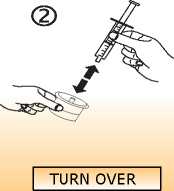
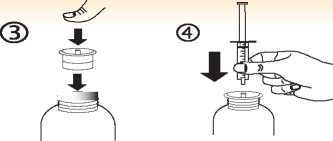
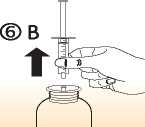
8).
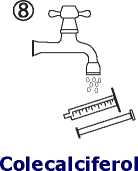
hospital casualty
6. Contents of the pack and other information
POM
c) Turn the bottle upside down. Fill the syringe with a small amount of solution by pulling the piston down (figure 5A), then push the piston upwards in order to remove any possible bubble (figure 5B). Pull the piston down to the graduation mark corresponding to the quantity in millilitres (ml) prescribed by your doctor (figure 5C, this pictogram represents an example for measuring a dose of 0.17ml).
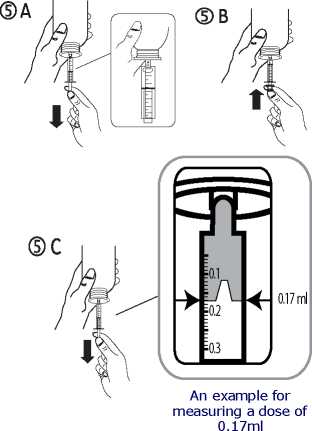
The total volume delivered from the syringe is 1ml with each numbered increment of 0.1ml, which is equivalent to 300 IU colecalciferol. Each of the 0.1ml increment is further divided into ten divisions and each of these divisions represent 0.01ml, equivalent to 30 IU Colecalciferol (see figure below).

Dose measurement - The maximum dose of colecalciferol is 1.33ml. Divide your dose into two (1ml & 0.33ml). Take one full syringe with solution up to 1ml mark. Then take 0.33ml by measuring the solution to 0.3ml and 3 further small divisions (as shown in the figure above using arrow).
d) Turn the bottle the right way up (figure 6A). Remove the syringe from the adaptor (figure 6B).
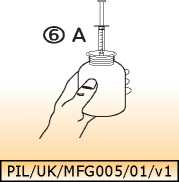
e) Empty the contents of the
syringe into the patient's mouth by pushing the piston to the bottom of the syringe (figure 7). Close the bottle with the plastic screw cap. Wash the syringe with water (figure
If you take more than you should
Contact your nearest department or tell your doctor immediately.
Taking more than the recommended dose may lead to abnormally high levels of calcium in the blood which can eventually damage the soft tissues and kidney.
Symptoms of overdose may include: lack of appetite, thirst, nausea, vomiting, constipation, abdominal pain, muscle weakness, fatigue, mental disturbances, increased urination, bone pain and in severe cases may result in coma and death.
If you forget to take Colecalciferol
If you forget a dose, take it as soon as you remember. However, if it is nearly time for the next dose, skip the missed dose.
Do not take a double dose to make up for a forgotten dose.
If you stop taking Colecalciferol
Keep taking this medicine until your doctor tells you to stop. Do not stop taking Colecalciferol just because you feel better.
If you have any further questions on the use of this product, ask your doctor or pharmacist.
■--
4. Possible side effects
Like all medicines, this medicine can cause side effects, although not everybody gets them.
Uncommon (may affect up to 1 in 100 people):
► Too much calcium in your blood (hypercalcaemia). Symptoms may include nausea, vomiting, lack of appetite, constipation, stomach ache, bone pain, extreme thirst, increased urination, muscle weakness, drowsiness and confusion;
► Too much calcium in urine (hypercalciuria).
If you are on long-term treatment, your doctor may wish to check the level of calcium in your blood and urine as well as your kidney functions.
Rare (may affect up to 1 in 10,000 people):
► Itching
► Rash
► Urticaria
Reporting of side effects
If you get any side effects, talk to your doctor or pharmacist. This includes any possible side effects not listed in this leaflet. You can also report side effects directly via the yellow card system at www.mhra.gov.uk/yellowcard.
By Reporting side effects you can help provide more information on the safety of this medicine.
f \
5. How to store Colecalciferol Oral Solution
v_
► Keep out of the sight and reach of children.
► Do not use after the expiry date, which is printed on the carton and bottle label after 'Exp'. The expiry date refers to the last day of that month.
► Do not store above 25°C.
► Store in the original package. Keep bottle in the original carton in order to protect from light.
► Discard 60 days after first opening.
► Do not use this medicine if you notice that the solution becomes discoloured or shows any signs of deterioration. Seek the advice of your pharmacist.
► Do not throw away any medicines via wastewater or household waste. Ask your pharmacist how to dispose of medicines you no longer use. These measures will help protect the environment.
What Colecalciferol Oral Solution contains
The active substance is colecalciferol. Each ml contains 3000IU colecalciferol. Also contains arachis oil (peanut oil). The other ingredients are refined almond oil and refined sunflower oil.
What Colecalciferol Oral Solution looks like and contents of the pack
Colecalciferol Oral Solution is a clear, yellow coloured solution supplied in amber glass bottles with a tamper-evident child-resistant plastic screw cap. Colecalciferol Oral Solution is supplied in bottles containing 100ml solution along with a 1ml oral syringe with 0.01ml graduations and LDPE adaptor.
Marketing Authorisation Holder and Manufacturer:
Syri Limited, t/a Thame Laboratories,
Unit 4, Bradfield Road, Ruislip,
Middlesex, HA4 0NU, UK.
Tel: +44 208 515 3700
This leaflet was last revised in 12/2014.

Thame Laboratories